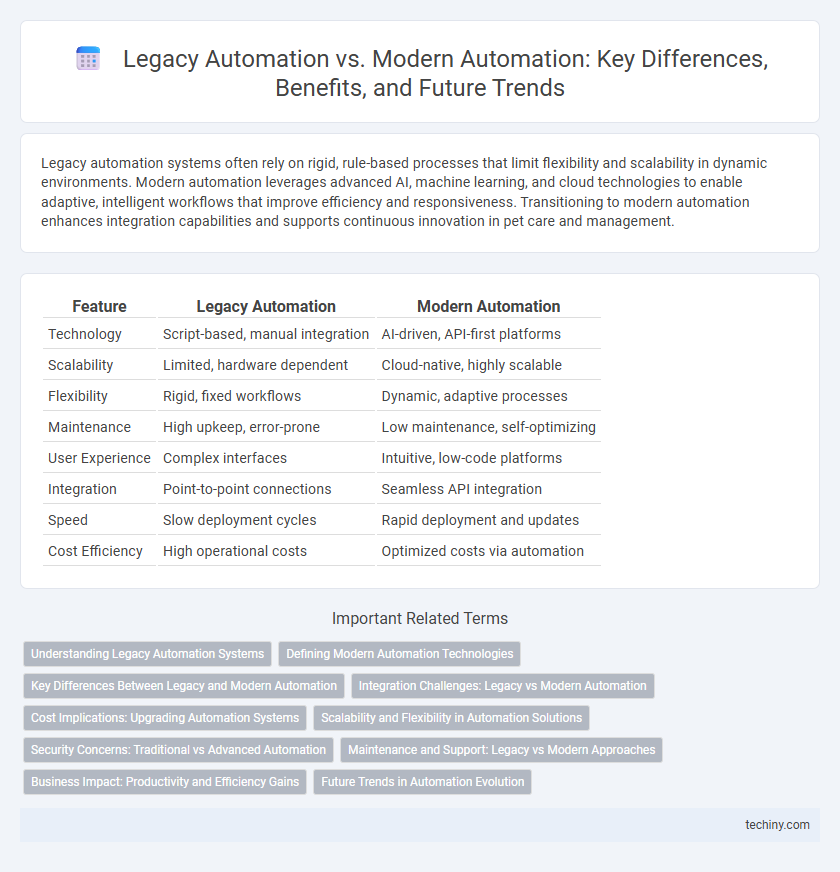Legacy automation systems often rely on rigid, rule-based processes that limit flexibility and scalability in dynamic environments. Modern automation leverages advanced AI, machine learning, and cloud technologies to enable adaptive, intelligent workflows that improve efficiency and responsiveness. Transitioning to modern automation enhances integration capabilities and supports continuous innovation in pet care and management.
Table of Comparison
| Feature | Legacy Automation | Modern Automation |
|---|---|---|
| Technology | Script-based, manual integration | AI-driven, API-first platforms |
| Scalability | Limited, hardware dependent | Cloud-native, highly scalable |
| Flexibility | Rigid, fixed workflows | Dynamic, adaptive processes |
| Maintenance | High upkeep, error-prone | Low maintenance, self-optimizing |
| User Experience | Complex interfaces | Intuitive, low-code platforms |
| Integration | Point-to-point connections | Seamless API integration |
| Speed | Slow deployment cycles | Rapid deployment and updates |
| Cost Efficiency | High operational costs | Optimized costs via automation |
Understanding Legacy Automation Systems
Legacy automation systems rely heavily on outdated hardware and proprietary software, limiting scalability and integration with modern technologies. These systems often operate on rigid, manual configurations that hinder efficiency and adaptability in dynamic production environments. Understanding legacy automation requires analyzing their architecture constraints, communication protocols, and maintenance challenges to effectively plan modernization strategies.
Defining Modern Automation Technologies
Modern automation technologies leverage cloud computing, artificial intelligence, and machine learning to deliver scalable, adaptive, and intelligent workflows, contrasting sharply with the rigid and rule-based frameworks of legacy automation systems. These advanced tools enable real-time analytics, predictive maintenance, and seamless integration across diverse platforms, driving higher efficiency and reduced operational costs. Emphasizing modularity and API-driven architectures, modern automation supports continuous improvement and faster deployment cycles in dynamic business environments.
Key Differences Between Legacy and Modern Automation
Legacy automation relies heavily on rigid, rule-based systems with limited scalability and integration capabilities, often resulting in slower deployment and higher maintenance costs. Modern automation leverages AI-driven technologies, cloud computing, and advanced analytics to enable real-time decision-making, seamless integration across platforms, and enhanced adaptability. Key differences include flexibility, speed of implementation, scalability, and the ability to handle complex, dynamic processes.
Integration Challenges: Legacy vs Modern Automation
Legacy automation systems often struggle with integration due to outdated protocols and limited compatibility with contemporary software and hardware platforms. Modern automation leverages APIs, cloud-based solutions, and standardized communication protocols, enabling seamless integration across diverse systems and real-time data exchange. The complexity and rigidity of legacy automation increase maintenance costs and hinder scalability, whereas modern automation frameworks support agile, interoperable environments essential for digital transformation initiatives.
Cost Implications: Upgrading Automation Systems
Upgrading legacy automation systems often incurs high costs due to outdated hardware, complex integration, and extended downtime during implementation. Modern automation solutions leverage cloud computing, IoT, and AI technologies, significantly reducing maintenance expenses and enabling scalable, cost-effective upgrades. Investing in modern automation enhances operational efficiency and delivers lower total cost of ownership compared to legacy systems.
Scalability and Flexibility in Automation Solutions
Legacy automation systems often struggle with scalability due to rigid architectures and limited integration capabilities, hindering adaptation to evolving business needs. Modern automation solutions leverage cloud-native technologies, microservices, and AI-driven workflows to provide unparalleled scalability and flexibility across diverse environments. These advancements enable seamless expansion, real-time adjustments, and efficient resource allocation, ensuring automation adapts dynamically to changing operational demands.
Security Concerns: Traditional vs Advanced Automation
Legacy automation systems often suffer from outdated security protocols, leaving critical infrastructure vulnerable to cyberattacks and unauthorized access. Modern automation integrates advanced encryption, real-time threat detection, and zero-trust architectures, significantly enhancing system resilience against evolving cybersecurity threats. Implementing modern security frameworks reduces downtime and protects sensitive data in increasingly connected industrial environments.
Maintenance and Support: Legacy vs Modern Approaches
Legacy automation systems often require extensive manual maintenance and depend on outdated technologies, resulting in higher downtime and costly support. Modern automation leverages cloud-native architectures, AI-driven diagnostics, and continuous updates to reduce maintenance efforts and enhance system reliability. Advanced monitoring tools and modular designs enable faster troubleshooting and more efficient support workflows in contemporary automation environments.
Business Impact: Productivity and Efficiency Gains
Legacy automation systems often suffer from rigid architectures and limited integration capabilities, resulting in slower productivity improvements and inefficiencies in workflow management. Modern automation leverages advanced AI, machine learning, and cloud-based platforms to deliver significant gains in operational efficiency, reducing manual errors and accelerating process completion times. Businesses adopting modern automation experience enhanced scalability, real-time data analytics, and improved resource allocation, driving higher overall productivity and cost savings.
Future Trends in Automation Evolution
Legacy automation relies heavily on rigid, rule-based systems with limited adaptability, while modern automation leverages AI-driven algorithms and machine learning for dynamic process optimization. Future trends in automation evolution emphasize hyperautomation, integrating advanced analytics, robotic process automation (RPA), and artificial intelligence to create seamless, end-to-end workflows. The adoption of edge computing and IoT will further enhance real-time decision-making capabilities and operational efficiency across industries.
Legacy Automation vs Modern Automation Infographic

 techiny.com
techiny.com